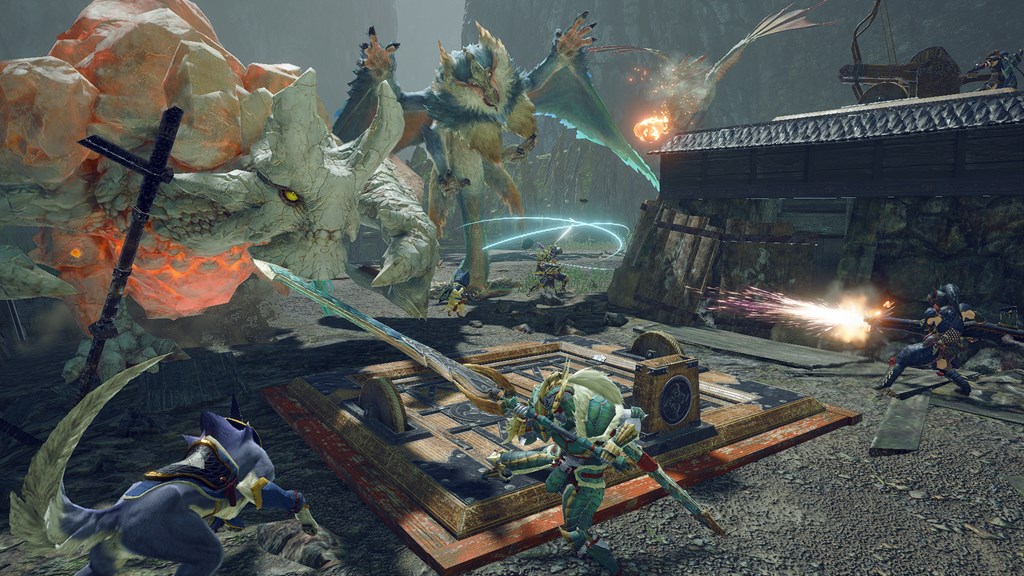Available On: Switch
Played On: Switch
The Monster Hunter series is nothing if not iterative. While the core gameplay loop of fighting big boss monsters and using harvested monster parts to craft better gear to take on stronger monsters remains engaging and fun, each new entry pushes the series forward.
With new skills expanding each Hunter’s arsenal, a smartly designed hub village, and a perfect balance of escalating threats, Monster Hunter Rise is easily one of the most impressive Monster Hunter games yet.
Fluffy Bunny Dango
Monster Hunter Rise is set in the lands surrounding Kamura village, which is heavily inspired by classic Japanese architecture and culture. We’ll be spending a ton of time in Kamura, forging new weapons and armor, sending our meowcenary buddies off to gather supplies, and picking up new hunting missions and requests from the villagers.
Kamura is elegantly laid out, with the weapon crafter, quest hub, and canteen all within a stone’s throw of each other. Add an easy-to-use fast travel system and near instantaneous load times, and you have a hub village that’s actually pleasant to maneuver around, rather than a tedious stop-over in between hunts. Plus, who could skip the adorable song and dance that accompanies each order of stat-boosting Fluffy Bunny Dango?
![]() But Monster Hunter is still about one thing: hunting monsters! If you’re a newcomer to the series, it’s an action game where you choose between 14 different weapons, each with their own unique styles, combos, and abilities, from the speed of the twirling dual blades to the methodical defense of the lance, as well as more outlandish weapons like the musical hunting horn and aerial insect glaive.
But Monster Hunter is still about one thing: hunting monsters! If you’re a newcomer to the series, it’s an action game where you choose between 14 different weapons, each with their own unique styles, combos, and abilities, from the speed of the twirling dual blades to the methodical defense of the lance, as well as more outlandish weapons like the musical hunting horn and aerial insect glaive.
Hunts and missions are divided up into single-player village quests, which advance the story, and the Hub, where we can hunt together online (or solo) in a never-ending search for the best gear and tougher monsters. The village quests provide a wonderfully balanced learning curve as I take on easier monsters like Great Wroggi and Lagombi, working my way up to trickier foes like the lighting-blasting Khezu, ice-blade Goss Harag, and the classic fire-spewing Rathalos. Seeing the credits roll after taking on the powerful Magnamolo is only the beginning, as High Rank unlocks even more weapons and gear, and much more powerful versions of the monsters.
One Giant Leap
Veterans will enjoy two big new features to Rise: Switch skills, and the wirebug. Switch skills are gradually unlocked by playing the story. They unlock alternate abilities for some of the attacks, often significantly changing how that weapon is used.
For example, the first Switch skill for my beloved Charge Blade replaces my sword charge with a spinning chainsaw of death in axe mode. It’s visually stunning, but at the cost of spending more time in the slower axe mode. Switch skills can be easily swapped when changing equipment, making it entirely possible, and sometimes necessary, to swap skills depending on the monster, just as I would with my other gear.
![]() The wirebug really puts the rise in Monster Hunter Rise, adding a new Spider-man-like web-slinging to both combat and exploration. With my weapon sheathed I can use the wirebug to reach new heights, or use it to deploy new combat-moves, specific to each weapon – like a well-timed counter guard for Charge Blade and Gunlance that refills my vials and shells.
The wirebug really puts the rise in Monster Hunter Rise, adding a new Spider-man-like web-slinging to both combat and exploration. With my weapon sheathed I can use the wirebug to reach new heights, or use it to deploy new combat-moves, specific to each weapon – like a well-timed counter guard for Charge Blade and Gunlance that refills my vials and shells.
Wirebugs also grant the ability to ride monsters, replacing World’s ability to briefly jump on a monster’s back with full control of a monster’s movement and attacks. Sometimes the best course of action is to simply run the monster into a wall, but if there’s another beast around, it’s kaiju battling time!
Finally there’s an all-new hunt mode called Rampage. Rampage is an interesting mix of tower defense and the more cinematic hunt of Zorah Magdaros from Monster Hunter World (which was terrible). We’re given a small-ish arena to defend, and certain spots to build towers that can be operated by NPC villagers or the hunters themselves. Waves of monsters begin to attack the gate, with the goal of surviving and repelling them all.
It’s an idea that sounds cooler on paper than in game. The turrets do far more damage than a hunter’s weapons, and monsters simply run and disappear when heavily injured, save for the final foe. Rampages are a nice break from the traditional hunts, but certainly not my go-to mode.
 The Rating
The Rating
Monster Hunter Rise is rated T for Teen with Blood, Violence, and Alcohol. It’s not a particularly bloody or overly violent series, but you are spending the majority of your time in lengthy, third-person action battles with huge monsters.
The Takeaway
All the big (and small) additions in Rise, from wirebug grappling to the new Palamute dog mount, go a long way in improving the classic Monster Hunter formula. Rise is also technical marvel for the Switch, pushing the console into new heights with smooth framerate, fun and varied regions, and lightning-fast load times. Monster Hunter Rise is one of the best games of the year, and a must-have game for the Nintendo Switch.



